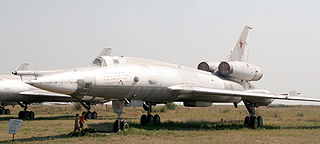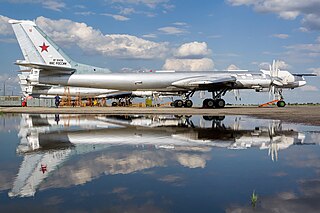
Surveillance aircraft are aircraft used for surveillance. They are primarily operated by military forces and government agencies in roles including intelligence gathering, maritime patrol, battlefield and airspace surveillance, observation, and law enforcement.

The Tupolev Tu-16 is a twin-engined jet strategic heavy bomber used by the Soviet Union. It has been flown for almost 70 years. While many aircraft in Soviet service were retired after the Cold War ended, the Chinese license-built version Xian H-6 remains in service with the People's Liberation Army Air Force, with the most modern variant, the H-6K, still being actively produced as of 2020.

The Tupolev Tu-110 was a jet airliner designed and built in the USSR, which saw its maiden flight in 1957.

The Tupolev Tu-22 was the first supersonic bomber to enter production in the Soviet Union. Manufactured by Tupolev, the Tu-22 entered service with Long-Range Aviation and Soviet Naval Aviation in the 1960s.

The Tupolev Tu-95 is a large, four-engine turboprop-powered strategic bomber and missile platform. First flown in 1952, the Tu-95 entered service with the Long-Range Aviation of the Soviet Air Forces in 1956 and was first used in combat in 2015. It is expected to serve the Russian Aerospace Forces until at least 2040.

The Tupolev Tu-22M is a supersonic, variable-sweep wing, long-range strategic and maritime strike bomber developed by the Tupolev Design Bureau in the 1960s. The bomber was reported as being designated Tu-26 by Western intelligence at one time. During the Cold War, the Tu-22M was operated by the Soviet Air Forces (VVS) in a missile carrier strategic bombing role, and by the Soviet Naval Aviation in a long-range maritime anti-shipping role.

The Kh-55 is a Soviet/Russian subsonic air-launched cruise missile, designed by MKB Raduga in the 1970s. It has a range of up to 2,500 km (1,350 nmi) and can carry nuclear warheads. Kh-55 is launched exclusively from bomber aircraft and has spawned a number of conventionally armed variants mainly for tactical use, such as the Kh-65SE and Kh-SD, but only the Kh-555 appears to have been put into service. The Kh-55 was not the basis of the submarine and ground-launched S-10 Granat or RK-55 Relief designed by NPO Novator. The RK-55 is very similar to the air-launched Kh-55 but the Kh-55 has a drop-down turbofan engine and was designed by MKB Raduga.

The Myasishchev M-50 is a Soviet prototype four-jet engine supersonic strategic bomber which never attained service. Only one flightworthy prototype was built, which was first flown in October 1959. The M-50 was constructed by the Myasishchev design bureau.
The Kuznetsov Design Bureau was a Russian design bureau for aircraft engines, administrated in Soviet times by Nikolai Dmitriyevich Kuznetsov. It was also known as (G)NPO Trud and Kuybyshev Engine Design Bureau (KKBM).

Unmanned aerial vehicles (UAVs) include both autonomous drones and remotely piloted vehicles (RPVs). A UAV is capable of controlled, sustained level flight and is powered by a jet, reciprocating, or electric engine. In the twenty-first century, technology reached a point of sophistication that the UAV is now being given a greatly expanded role in many areas of aviation.

The Tumansky R-15 is an axial flow, single shaft turbojet with an afterburner. Its best known use is on the Mikoyan-Gurevich MiG-25.

The Lavochkin La-17 was the first Soviet unmanned aerial vehicle (UAV) to reach operational service. The first versions were developed in the early 1950s, and remained in service into the 1980s.

The Tupolev Tu-123 Yastreb was one of the earliest Soviet reconnaissance drones that began development in 1960. Sometimes referred to as the "DBR-1", it was introduced into active service in 1964.

The Tupolev Tu-141 Strizh is a Soviet reconnaissance drone that served with the Soviet Army during the late 1970s and 1980s, as well as the Ukrainian Armed Forces since 2014.

Engels-2 is a strategic bomber military airbase in Russia located 14 kilometres (8.7 mi) east of Saratov. Engels is a major bomber operations base, and is Russia's sole operating location for the Tupolev Tu-160 strategic bomber. The base has a 3,500-metre (11,500 ft) runway and about 10 large revetments. It is named after the nearby city of Engels, which is named after the Communist philosopher, Friedrich Engels.

The Kolesov RD-36 was a supersonic turbojet engine used on various Soviet aircraft projects.

The HESA Karrar is an Iranian jet-powered target drone manufactured by Iran Aircraft Manufacturing Industrial Company (HESA) since 2010. The Karrar is a derivative of the American 1970s-era Beechcraft MQM-107 Streaker target drone, probably incorporating elements from the South African Skua, with hardpoints added for munitions. The Karrar was developed during the Ahmadinejad presidency.
The Tupolev Voron was a planned supersonic unmanned reconnaissance aircraft of the Soviet Union manufactured by the company Tupolev, largely based on or designed to compete with the Lockheed D-21.

The 383rd Separate Brigade of Unmanned Aviation Complexes is a unit of the Ukrainian Air Force armed with Unmanned Aerial Vehicles and is directly subordinated to the Air Force command. It was established during the Soviet era as a reconnaissance UAV Regiment. It is the only unit of the Ukrainian Air Force operating Tupolev Tu-141, Tupolev Tu-143 and Bayraktar TB2.


















